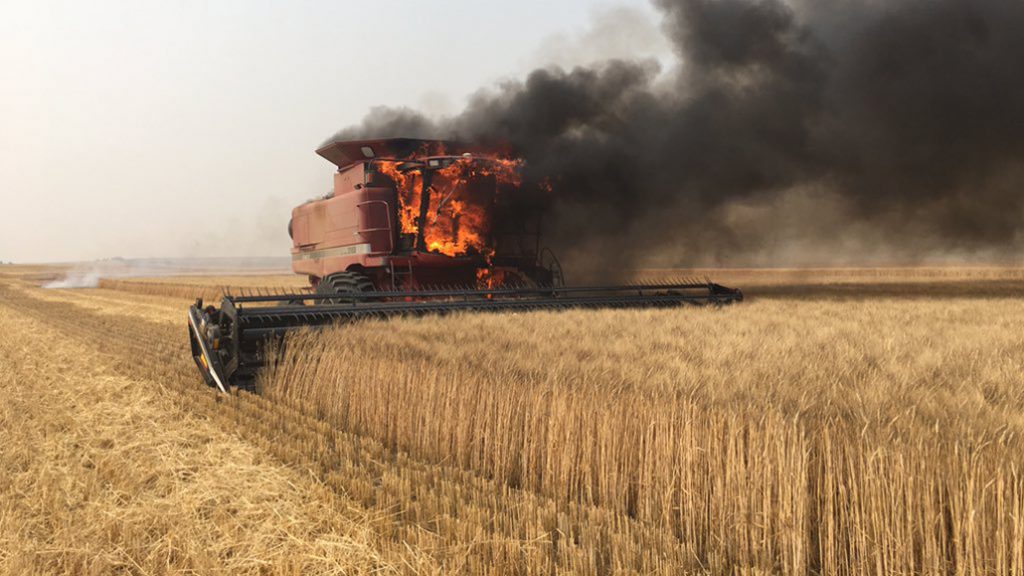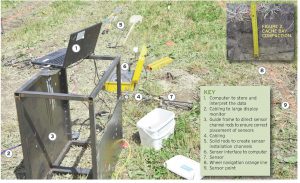An ounce of prevention
FIRE SAFETY AT HARVEST TIME

IT STARTED WITH a burning smell while unloading grain, then sparks and flames — all within the span of just a few minutes.
A grain farmer, who requested that he not be identified, was harvesting corn with his daughter. The pair were moving grain from their combine to grain wagons parked on the edge of a field.
Just as they finished filling the first wagon, the daughter noticed a burning smell, then saw sparks coming from the top-rear of the combine that quickly grew into a small fire.
Problem was, neither the farmer nor his daughter had any water with them, and the fire extinguisher on the combine had expired. The farmer’s daughter ran towards their pickup truck parked nearby to find something they could use to control the fire, while he tried to disconnect the combine’s alternator. The daughter grabbed old blankets and rags from the truck, which she and her father used to smother the flames around the combine’s engine compartment.
Even though no one was injured, and they managed to save their combine, the farmer and his daughter realized that the whole fire incident could have been far worse.
“We were very fortunate that we were at the front of the field, standing still, and with our truck close by when the fire happened. If we had been at the back of the field — or further away — we probably would have lost the combine — or worse,” says the farmer. “We also learned a valuable lesson about keeping a working fire extinguisher on every single piece of equipment we run.”
The farmer later discovered that a bearing in the combine’s alternator had snapped, sending out a shower of sparks that caught a protective plastic shield on fire.
PREPARATION AND PREVENTION
During his 15 years on the job, Jeff Denys, volunteer district fire chief for the Bluewater Fire Department in Brucefield, Ont., has heard this type of story more than he would like. He has responded to a number of fires around harvest time.
He says one of the most common causes of a fire is a pickup truck driven into a dry field and parked over stubble.
“What people sometimes don’t realize is that the exhaust and catalytic converter on those trucks are piping hot against stubble or leftover field residues,” Denys says. “And by the time you even notice that there is a fire, it’s already too late to save the vehicle.”
Denys urges farmers to always err on the side of caution and keep “non-field” machinery out of the field.
“Roughly speaking, a fire doubles in size every minute — so it’s not something you want to risk,” he says.
Another cause of fire on grain farms is equipment or engine failure.
“Usually when you see a fire problem, it’s with a bearing that is worn out and overheated on a combine or tractor,” Denys says. “And that’s not always necessarily due to bad maintenance — some bearings aren’t easy to access, so you may be dealing with a problem you can’t see.”
That being said, Denys points out that fire extinguishers tend to be the most overlooked piece of fire prevention equipment.
“I don’t know how many times I’ve seen a fire extinguisher on a combine or other large piece of equipment that’s way undersized,” he says. “When stubble or rubbish in an engine catches fire, there is ample fuel and it spreads extremely quickly. You can’t knock down a fire with a one-pound or two-pound extinguisher.”
Instead, Denys recommends that farmers have, at minimum, a five-pound or even 10-pound extinguisher on their equipment — especially in the combine. While a larger extinguisher can seem bulky in a combine cabin, they provide more of a fighting chance in an emergency.
“While it’s definitely possible to be overkill on many things in life, the size of your fire extinguisher isn’t one of them,” he says.
ASSESS THE DANGER
Jeff Allan, volunteer fire captain with the Bluewater Fire Department in Brucefield — and full-time farmer — points out that even with a fire extinguisher on-hand, farmers also need to recognize when to get away before someone is seriously hurt.
“You can always buy a new piece of equipment, but you can’t buy a new life — and I know sometimes it’s natural instinct in the moment to try to reduce your losses and save that machine,” Allan says. “But a fire extinguisher only lasts about 10 seconds and after that, you don’t know if the fire is going to flare up again.”
Denys says that farmers should ultimately leave any firefighting to the professionals — no matter how small a fire might seem.
“You can’t and should never handle a fire — that’s the quick and simple answer. The bigger a fire gets, the more it creates its own behaviour and can quickly put you at risk of injury,” he explains. “By the time you realize that you need to call 911, it’s already too late — especially when you’re dealing with a field fire. You alone can’t possibly provide enough suppression, and you should never risk your own safety to try and save inanimate objects.”
COMBINES
To help reduce the risk of fire on a combine at harvest, Ray Cartier, service manager at McGrail Farm Equipment in Chatham, says it’s important for farmers to make sure they are keeping the area around the primary countershaft and engine powershaft clear of excessive crop material and chaff.
“The areas right behind the cab tend to be where you have a lot of heat, so it’s always a good idea after harvesting to dust the machine off with a leaf blower,” he says.
He adds that farmers should keep an eye on engine compartments, as birds are prone to building nests that can cause fires when heated by an engine block.
In addition, any oil leaks should be immediately washed off and repaired, as crop material can get stuck and heat up.
Cartier also recommends that farmers regularly grease and run their machine while checking with a heat gun to detect whether any bearings may be running hotter than normal.
“You’re used to a certain heat range that bearings run at, whether it’s a bigger shaft, smaller shaft, or higher speed shaft — or a shaft that’s running in an area that’s bringing in material,” says Cartier. “The heat gun can help tell you whether you have any trouble spots.”
GRAIN BINS AND DRYER SYSTEMS
For Deni Spencer, construction manager at Devolder Grain Systems in Chatham, keeping grain dryers up, running, and fire safe is all part of a full, preventative maintenance program.
“With our clients, we’ll typically go in, check and grease bearings, check wear on some of the belts, sensors, tubing, and flighting,” he says. “We will also take a close look at the cleanliness of the grain bin itself.”
Spencer adds that any grain bin fires he has seen have been mainly due to a buildup of crop materials, such as red dog or fines, that can create hot spots. He says farmers should look closely at their under-floor systems and remove any leftover residues, which can prove flammable in the right conditions.
For maintenance timing, Spencer says that farmers should do a major clean at the very end of the season when grain bins have been emptied. Then, start a preventative maintenance program in the early spring and summer to allow for as much time as possible before harvest.
“You don’t want to be doing your preventative maintenance in the first week of October and then try to dry grain the next day – timing is definitely key,” he says.
In addition to proper, regular maintenance, Spencer emphasizes that farmers need to run their dryer systems within the manufacturers’ recommendations for grain drying heat and volume.
“Where you can run into trouble is when you start bypassing safety and running things a little too hard or too hot and pushing limits,” he says. •


























